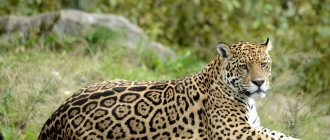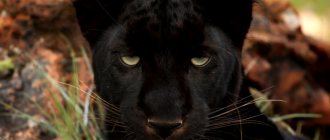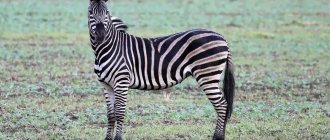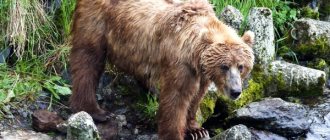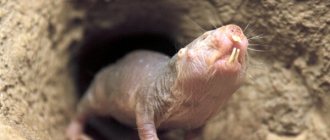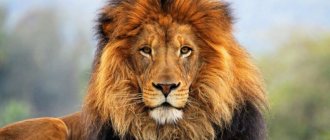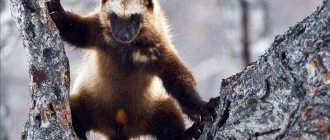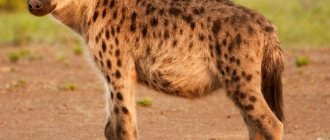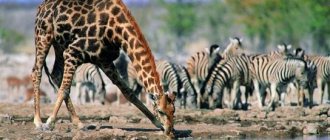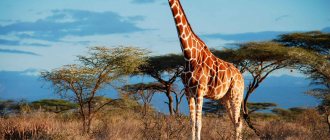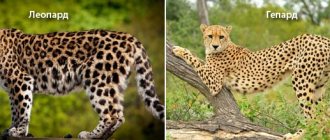The puma is a predatory mammal of the Felidae family, subfamily of small cats. Found in the Americas, from the Canadian Yukon to the Southern Andes, it is the most widespread large wild mammal in the Western Hemisphere. The largest representative of the puma genus, the second largest wild cat in the New World after the jaguar. Among felines, it is second in size only to the lion, tiger and jaguar. The cougar is also known as the cougar, mountain lion, and panther.
Description
The name puma comes from the Quechua Indian language and means “powerful.” This word was borrowed first by the Spaniards in the 16th century, then by the British in the 18th century. An alternative name, cougar, comes from the Portuguese çuçuarana,
The Portuguese, in turn, borrowed the name from the indigenous inhabitants of southern Brazil. Early Spanish conquistadors nicknamed the predator the mountain cat, or simply the lion. In Canada and the western United States, the cougar was also called the mountain lion; the name first appeared in print in 1858.
The puma is listed in the Guinness Book of Records as the animal with the most names. In the English language alone there are more than 40 different names for this animal.
The animal's scientific name Puma Concolor (originally Felis Concolor) was proposed by Carl Linnaeus in 1771, who described the predator as a long-tailed wild cat from Brazil. From Latin, concolor is translated as one-color, which reflects the uniform color and complete absence of spots on the puma’s skin. The animal was assigned to the genus Puma by Scottish naturalist William Jardine in 1834. The puma's closest relatives are jaguarundi and cheetahs.
Puma is a quiet and graceful predator
In the cat family, the puma is considered one of the most graceful, strong, beautiful animals, first described in the mid-16th century. Another name for this big cat is cougar, or mountain lion.
What does a puma look like - size, color and appearance
The puma is a lithe and elegant wild cat of impressive size. Despite belonging to the subfamily of small cats, the puma is by no means small in size; it ranks fourth in size among all felines in the world, second only to the lion, jaguar and tiger. The puma is classified as a subfamily of small cats because of the structure of its pharynx - unlike big cats (jaguar, lion, tiger, leopard), the cougar cannot growl, only purr.
The height of the animal at the withers is on average from 60 to 90 cm. The length of the body including the tail varies from 1.5 to 2.75 meters, the average length of males is 2.4 m, for females - 2.05 meters. The tail length ranges from 63 to 95 cm. Adult males weigh from 53 to 100 kg (average weight 68 kg), females weigh 29-64 kg (average weight 55 kg). Males are on average 20-30% larger than females. The size of the predator increases with distance from the equator - animals living close to the equator are much smaller than individuals living in Canada or southern South America.
The puma has a flexible, long, muscular body, a round head and erect ears. The powerful jaws and neck of the animal are perfectly adapted for hunting. The tail is long and evenly pubescent. The paws are powerful and massive, with retractable claws, which allows the predator to climb trees and securely hold its prey. The animal's hind legs are proportionally the longest among all felines, which allows the predator to jump long distances. A puma can jump up a tree to a height of up to 5.5 meters.
The color of the puma is uniform, without spots, but the shade varies greatly. The skin of adult animals usually has a grayish-brown or brownish-yellow tint, with steel gray and reddish tones also being less common. The fur on the jaw, chin and throat is noticeably lighter. Due to the yellow color of the skin, like a lion, the puma was nicknamed the mountain lion. The animal's fur is short and coarse, but quite thick. Predators living in the tropics are distinguished by a brighter red color, while their northern relatives are painted predominantly gray.
The black puma does not occur in nature, so the famous black panther is either a jaguar or a leopard with a genetically abnormal black coat (melanism). The albino white puma was recorded on video in 2013, so it is found in nature, although it is extremely rare.
Behavior
Cougars are extremely agile and energetic. These are strong athletes, climbing trees and jumping long distances of up to 12 meters with equal ease in pursuit of their prey. Their maximum running speed is 65-80 km/h.
Cougars are diurnal solitary hunters who unite in pairs only during the breeding season, but such breeding associations exist only for 1-6 days. Cougars are usually silent animals, but during the mating season they emit frightening, drawn-out screams with short breaks of several hours. Unlike other felines, such as the lion or tiger, the puma does not growl , but purrs, like a regular domestic cat. This feature is the reason for the exclusion of the puma from the genus Panthera.
Character and lifestyle
Like most other cats, cougars lead a solitary lifestyle. Adult animals meet exclusively for mating. Females live in small groups with their young until the kittens are 2 years old. Adult predators live in their own territory.
The size of the animal's hunting range varies from 150 to 1,000 square kilometers, depending on the terrain and prey density. In this case, the male’s territory is usually at least 2 times larger than the female’s territory. A male's territory may include or overlap with that of several females, but a male's territory never overlaps. Predators mark their territory using urine, feces and claw marks, in a similar way that pumas look for a mate.
Although the cougar is capable of fast sprinting, the predator's favorite method of hunting is an ambush attack. The animal sneaks up on its prey unnoticed in thickets of trees and bushes, and jumps on the victim’s back, trying to break the neck with a powerful jump or grab the throat with a suffocating bite. On average, the cougar consumes about 800-1300 kg of meat per year, and kills a large ungulate every 1-2 weeks. For females with cubs, this interval is reduced to 3 days, especially if the kittens are already grown up.
After a successful hunt, the predator drags the prey to a secluded place, hides it among the bushes, and then returns within a few days to finish eating. The cougar is capable of dragging prey weighing 5-7 times its own weight. On occasion, the puma kills more animals than it can eat and hides the prey in reserve. The Indians picked up the carcasses of the predator, knowing about this feature.
Interesting Facts:
- Cougars rarely attack people and prefer to avoid them. If a person moves quickly and is alone, then at dusk or at night a cougar may mistake him for prey and attack.
- The age of a puma is determined by the condition of its teeth. The animal's milk teeth erupt at 4 months. Permanent teeth appear at 6-8 months, and by 1.5-2 years they are completely erupted. With age, they noticeably wear off and darken.
- The puma is capable of dragging its prey over a long distance, even if it weighs 5-7 times more than the predator itself. The Indian tribes who lived in California used this habit of pumas, and picked up eaten and untouched carcasses after predators.
What does a puma eat?
Like other cats, the puma is a typical meat-eating predator. Most of the predator's diet in North America consists of various species of ungulates, mainly deer. In South America, the share of ungulates in the animal diet drops significantly. South American predators prefer small and medium-sized animals as prey, this is due to active competition with the jaguar, a larger cat.
The main diet of pumas consists of the following types of animals:
- deer - black-tailed deer, white-tailed deer, wapiti (American red deer), pampas deer, caribou (reindeer), fallow deer
- moose
- rams - bighorn rams (thick-horned rams), Dall rams (thin-horned rams)
- mountain goats
- coyotes
- American badger and American mink (eastern mink)
- pronghorn (pronghorn antelope)
- porcupines and armadillos
- raccoons
- harbor seal and California sea lion (northern sea lion)
- otters and beavers
- hares and rabbits
- capybara and peccary
- guanaco and vicuna
- rhea and wild turkey
Because the cougar is so widely distributed geographically, the animal's diet varies greatly depending on its habitat. Cougars in South America often eat small reptiles and fish, which is rare in North America. In Patagonia, pumas specialize in penguins. In Canadian Columbia, the main species hunted are raccoons, seals and sea lions.
If there is a lack of food, the puma will not disdain other game: on occasion, the predator can hunt rabbits, squirrels, opossums, muskrats, sloths, monkeys, skunks, agoutis, lynxes and alligators. The animal even eats mice, snails and insects. The predator does not know the difference between domestic and wild animals, and without fear attacks livestock - pigs, horses, dogs and cats, and poultry.
Puma at home
The fashion for keeping wild cats at home has been growing rapidly in recent years. Cougars are no exception - there are a lot of offers for sale of kittens on the Internet, and on YouTube there are videos about keeping mountain lions in captivity.
Before you take on this responsibility, consider that living with a cougar is not easy. To do this, you will need either an enclosure or a room specially designated for this purpose, regular veterinary support, expensive food, etc. In addition, even a tamed puma remains a wild cat that obeys natural instincts. It follows from this that there can be no talk of complete safety for humans and other domestic animals. You should also remember that only kittens can be tamed.
Naturalists who have studied pumas claim that they are suitable for keeping at home, but they will not give up hunting birds. If the farm has chickens, ducks or geese, the owner who lets the cougar out into the yard will have to come to terms with the loss of the birds.
Baby cougars are fed mainly with milk and boiled meat, cereals and vegetables - if they are cooked in meat broth.
As pumas grow older, they switch to raw meat. A cat eats up to 2 kg of raw beef per day. Like other cats, the cougar licks meat before eating it, and after a hearty meal, it washes itself and sleeps for several hours in a row.
Cougars drink a lot of water and eat fresh grass. Vitamin supplements are introduced into the diet after consultation with a veterinarian.
Cougar cubs in the house behave like ordinary kittens: they play a lot, communicate with the owner and other pets. Small spotted cougars look attractive and chirp funny. In a good mood, cougars purr like ordinary domestic cats, they grumble out of irritation, and snort out of fear.
The puma can be walked on a leash in the forest or park. An older cat is moved into an enclosure to avoid problems. Ideally, a private house with a fenced area and equipped with a spacious enclosure is suitable for the life of wild cats. You cannot keep a cougar in an ordinary small-sized apartment. Limited space has a negative effect on it, the cat begins to get bored and irritated for any reason.
Caring for the fur, eyes, ears, and claws is the same as for regular cats. You need to get used to skincare procedures from childhood in order to avoid problems in the future. You need to take special care of your claws, namely, trim them in a timely manner with a nail clipper.
How much does a puma cost in Russia?
The cost of a puma kitten ranges from 130-150 thousand rubles.
Where does the puma live?
The cougar has the widest range of any terrestrial wild animal in the New World. The cougar perfectly adapts to any environmental conditions - it can live in forests of any type, in prairies and mountains, in swamps and rocky canyons. The habitat of the animal usually coincides with the habitat of deer and other ungulates, as the main prey of the predator.
At the moment, in the east of North America the animal has been practically exterminated, with the only exception being a small enclave of Florida pumas in the state of Florida. Cougars remain in North America only along the west coast - from Alaska, Alberta and New Columbia, and south through Oregon and California. In South America, the animal is still found throughout the continent, all the way to Patagonia.
Distribution and habitats
Puma is an American cat.
Historically, the cougar's range was the largest of any land mammal in the Americas. The distribution area of this species extended from southern Patagonia to southeastern Alaska. Currently, in North America, the puma remains mainly in the mountains of the western regions. In South America, the puma is distributed almost everywhere. These predators adapt well to a wide variety of conditions: they live in mountain coniferous forests, tropical forests, and grassy plains. Cougars can be found in the mountains at altitudes of up to 4,700 m above sea level. Their spread is limited only by food and shelter. In addition, pumas in South America avoid floodplains where jaguars are found.
For a successful hunt, a puma needs shelter behind which it hides, creeping up on its prey, so even in open biotopes, the predator chooses areas where there are stones or bushes.
Reproduction and offspring
Females reach sexual maturity at the age of 1.5 to 3 years. On average, females give birth once every 2-3 years, although in some cases this period is reduced to one year. Estrus lasts 8 days out of a 23-day cycle. The animal's mating season lasts all year round, although in northern latitudes mating occurs mainly from December to March in order to raise the young in more favorable conditions in spring and summer. In captivity, animals reproduce poorly due to chronic stress.
Pregnancy lasts on average 91 days. A litter can have from 1 to 6 kittens, with an average of two babies born. On average, only 1 cub per litter survives. Caring for the offspring, like other cats, falls entirely on the shoulders of the females. Kittens are born blind and helpless, completely dependent on their mother. Up to 3 months, the cubs feed on breast milk, after which they begin to go hunting with their mother. From 6 months, young pumas hunt on their own, but remain with their mother until they are 2 years old. Males leave their mother in search of their own territory a little earlier, and wander until they stake out their own territory.
The color of the cubs is different from the adults. Kittens are born with dark spots, stripes on their paws and rings on their tail. The spots disappear completely between the ages of 9 months and 2 years. Kittens open their eyes 2 weeks after birth and initially have blue eyes. After 6 months, the animal's eye color changes to yellow, brown or amber.
Keeping animals at the Moscow Zoo
During the existence of the zoo, pumas were kept here several times. These cats live well in captivity and bear offspring. Currently, a young large male puma lives in “Cat Row”, who arrived from the Veliky Ustyug Zoo. He walks around the enclosure not only in the evening, like most cats, but is often active during the day. His daily diet includes 1.5 kg of beef, a little ox heart and 4-5 rats, which he eats with great appetite. The beast greets familiar people with a uterine sound that vaguely resembles a purr. We hope that our handsome guy will soon have a girlfriend, and they will make us happy with the birth of little spotted kittens.
Types of pumas
Up until the 1980s, zoologists recognized 32 different subspecies of pumas. With the help of genetic research, since 2005 the number of recognized subspecies has been reduced to 6.
- Puma concolor couguar. Lives in North America (from Canada to Guatemala and Belize)
- Puma concolor costaricensis
. Central America (Panama, Nicaragua, Costa Rica) - Puma concolor capricornensis.
Lives in eastern South America (from the Brazilian Amazon to Paraguay) - Puma concolor concolor.
Northern South America (Colombia, Guiana, Bolivia, Peru, Ecuador, Venezuela) - Puma concolor cabrerae.
Central South America (Argentina, Uruguay) - Puma concolor puma.
Southern part of South America (Chile, southeastern Argentina).
In 2022, scientists from the Feline classification group recognized only 2 subspecies of the animal:
- Pc Concolor in South America, except in the northwestern Andes.
- Pc Cougar in North and Central America, and northwestern South America.
One of the rarest suspected subspecies of the animal is the Florida cougar (Puma concolor coryi). Its current number is no more than 160 individuals. The Florida panther has been considered a separate subspecies of predator inhabiting the state of Florida since the late 19th century. Currently, the Florida puma has also been reclassified, and now belongs to the general subspecies of South American pumas, Puma Concolor Concolor.
№10
As we noted earlier, they can run quite fast, but over short distances. That is why it is difficult for them to catch up with prey, as, for example, cheetahs do.
Therefore, pumas prefer to hunt from ambush. They usually hide in tall grass, bushes, behind rocks or even in trees and wait until the animal gets close enough to be caught in one jump.
Natural enemies
The puma has no natural enemies; no one hunts it in nature. However, the animal faces stiff competition for prey from other predators. Grizzly bears, black bears, wolves and jaguars take at least 10% of the puma's prey, in some regions up to 40%. In northern latitudes, packs of wolves pose a great threat to pumas - a cougar is easily able to defeat one wolf, but is powerless against an entire pack. Therefore, cougars avoid wolf packs and try to raise kittens away from wolf habitats.
Grizzly bears are the dominant predators in their habitat. Not only cougars, but also other local predators - wolves and black bears - are forced to give them their prey. In South America, the dominant predator is the jaguar, whose territory often coincides with the cougar's hunting range. Therefore, South American pumas are often forced to hunt smaller prey than jaguars to avoid competition with the larger predator.
Large reptiles also pose a threat to cougars. Unlike jaguars, pumas are not as well adapted for hunting reptiles, so these predators stay away from bodies of water with large reptiles. Cases have been recorded of cougars being attacked by large alligators and pythons.
№6
If you look at the eyes of adults, they are greenish-yellow. But this eye color appears only in adults.
At birth, babies' eyes are closed, just like domestic kittens. They are closed until they are approximately 14 days old. When babies open their eyes, they will be bright blue. It takes about 16 months for the eyes to change from blue to greenish.
Population and conservation of the species
Since 2008, the puma has been listed as a species of Least Concern on the IUCN Red List. Currently, the total number of animals in the world is estimated at approximately 50,000 individuals. Hunting the animal is prohibited in the following countries:
- Costa Rica
- Honduras
- Nicaragua
- Guatemala
- Panama
- Venezuela
- Colombia
- French Guiana
- Paraguay
- Suriname
- Brazil
- Chile
- Uruguay
- Bolivia
In the United States and Canada, cougar hunting is only partially regulated and is still frequently practiced. In Canada, hunting is prohibited only in the Yukon. In the United States, the only state in which hunting animals without special permission is prohibited is California. In other states you can hunt. In Texas, cougars are considered a harmful predator to livestock, and hunting of the animal is even encouraged, and on animals of any gender, age, and in any quantity.
How many years do they live
The average life expectancy of pumas in nature ranges from 10 to 12 years. In captivity, if optimal conditions are created, the predator can live up to 18-20 years. The significant difference in the duration of the life cycle is associated with the death of cougars during attacks by natural enemies: jaguars, bears, caimans, alligators. Most often kittens and young individuals die. Thus, out of 4-5 newborn cubs, only one survives to the age of 2 years.
The most dangerous enemy of pumas is humans. Hunting for the animal and its uncontrolled shooting almost caused the complete extinction of the species.
№13
There is a hybrid of a puma and a leopard. It's called a pumapard. In the wild, such hybrids are never found, since the habitat of these wild cats does not overlap.
Pumapard, despite the fact that the parents are quite large cats, is prone to dwarfism. It is approximately 2 times smaller than the leopard and puma. It has very short legs and a disproportionately long tail.
We also recommend reading: Interesting facts about jaguars
The Amazing Swimmer Who Can't Growl
The animal is an excellent swimmer. It can cover more than 10 kilometers in one swim. The animal can use logs to make it easier to swim. By the way, the cat can hunt even in water.
The wild cat jaguar cannot growl at all. She makes hissing and snorting sounds before attacking. It is believed that the animal can imitate voices, in particular the sounds made by a baby monkey. The jaguar does this in order to attract monkeys and attack them.
Do pumas have natural enemies?
There are none; no one dares to attack an agile and strong adult puma. The same cannot be said about cougar cubs - wolves, jaguars or grizzlies are not averse to feasting on them.
The population of these animals is not so large, so many states where the puma lives have established a ban on catching this animal and now cougars are protected by law.
Do pumas have natural enemies? There are none; no one dares to attack an agile and strong adult puma. The same cannot be said about cougar cubs - wolves, jaguars or grizzlies are not averse to feasting on them. The population of these animals is not so large, so many states where the puma lives have established a ban on catching this animal and now cougars are protected by law.
If you find an error, please select a piece of text and press Ctrl+Enter.
